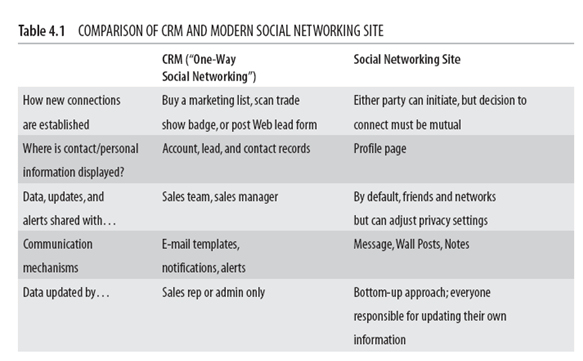Clara Shih On The Facebook Era (Part 3)
By Guest Author Clara Shih
[In last week’s posts Clara described the genesis and background of her work on Facebook as a business tool. Today she discusses how Facebook and other social networking sites have made the sales process more of an interaction between seller and customer.]
Excerpt from Chapter 4, “Social Sales”
One major result of the democratization of business has been unprecedented market competition. In today’s business landscape, companies are faced with a greater number of competitors and savvier buyers empowered with information. More than ever, sales reps must strive to maximize the lifetime value of their customer relationships versus maximizing the value of a single transaction. With fewer unfair structural advantages for reps to count on, timely insights into customer needs and interpersonal communications in the sales process have become requirements for closing the deal. Online social networks are emerging as critical business tools to help facilitate these insights and communications.
Transforming the Sales Cycle
Sales reps can use online social networking to become more productive in two ways: to glean insights about customers and to engage in casual communications with customers. From the customer’s perspective, the sales call has the potential to become more personalized and relevant. It’s no longer acceptable for reps to generically push every product and service.Today’s reps are expected to have “done their homework” based on the information available on the Internet and on social networking sites.
Sales Prospecting
Prior to social networking sites, it was both less efficient and less socially acceptable for a sales rep to directly prospect into her network. It was inefficient because there was no easy way to tell who among your contacts might be interested in your product. It was invasive because the sales rep burned through social capital each time she tried selling to someone who was not interested.
In the Facebook Era, it is a different story. LinkedIn and to a lesser extent Facebook typically have employment information (i.e., location, employer, and role) for each contact. The sales rep can search on the exact profile of the ideal target prospect and qualify the lead earlier in the cycle.The sales call feels less invasive because the interaction feels more casual and the pitch is targeted specifically to the prospective customer’s profile. The following case study profiles how one company, Aster Data Systems, successfully sourced its initial wave of customers using social networking sites.
CASE STUDY
Social Graph Prospecting at Aster Data Systems

Aster Data Systems, a start-up software company located in Silicon Valley, has dramatically grown its business through creative use of LinkedIn. As a small start-up, Aster lacked brand recognition, and did not have the budget for large marketing or advertising campaigns. To source early customers, Aster instead tapped into the company’s collective social network on LinkedIn, MySpace, and Facebook. Senior management asked all employees, not just sales reps, to tap their networks for potential prospects who had keywords like “data warehousing” in their title or functional expertise. In just a few months, the resourcefulness of this strategy has already begun to pay off. LinkedIn and other social networking sites are used to identify who among those contacts connected to Aster employees might be interested in the database product.Then a sales cycle is initiated through a combination of LinkedIn and traditional communication modes.Thanks to the power of the social graph, Aster has successfully signed on more than a dozen customers…
CRM—The First Social Network?
In many ways, traditional CRM was an important precursor to many of today’s social networking sites. At its most basic level, CRM is a fancy contact database. It is a one-way social networking tool that lets sales reps view “profiles” of their accounts, capture deal information, track performance, communicate with contacts, and share information internally with sales managers and other members of their account team.
Already, many of the innovations from social networking are making their way into CRM systems, as evidenced by the new deal collaboration features mentioned earlier and the partnership between Facebook and salesforce.com. Next-generation CRM tools will be even more bidirectional between vendors and customers—for example, Salesforce Ideas…which [takes] customer contributions to a user community and [captures] them directly inside of CRM. By making the customer an active participant in CRM, not only will companies benefit from more accurate data and better engagement, but they will also finally achieve a true 360-degree view of their customers across every touch point—whether it is online, on the phone, pre-sales, mid-deal, post-sales, or beyond.
Read more excerpts from The Facebook Era at thefacebookera.com.
This segment is part 3 in the series : Clara Shih On The Facebook Era
1 2 3 4
Featured Videos
Can 1M/1M Help Me Raise Money?
How Does 1M/1M Democratize Entrepreneurship Education?
How Does 1M/1M Democratize Management Consulting?
When Is The Right Time To Join 1M/1M?
Can 1M/1M Help Me With Business Development?
Can 1M/1M Help Me With Market Sizing?
Can 1M/1M Help Me Validate My Product?
Will I Have Private 1-on-1 Sessions In 1M/1M?
How Does 1M/1M Help Entrepreneurs Connect With Silicon Valley?
Mentoring or Consulting?
Why Does 1M/1M Charge $1000 a Year?
Why Does 1M/1M Partner With Local Organizations?
Why Don\’t Mentoring Networks Work?
Why Is It Important To Study With 1M/1M Now?
Dan Stewart Story
Vikrant Mathur Story
